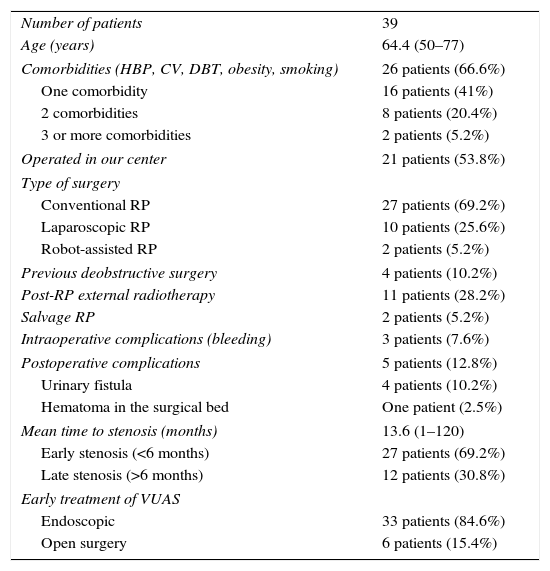Vesicourethral anastomotic stricture following prostatectomy is uncommon but represents a challenge for reconstructive surgery and has a significant impact on quality of life.
The aim of this study was to relate our experience in managing vesicourethral anastomotic strictures and present the treatment algorithm used in our institution.
Patients and methodsWe performed a descriptive, retrospective study in which we assessed the medical records of 45 patients with a diagnosis of vesicourethral anastomotic stricture following radical prostatectomy. The patients were treated in the same healthcare center between January 2002 and March 2015. Six patients were excluded for meeting the exclusion criteria. The stricture was assessed using cystoscopy and urethrocystography. The patients with patent urethral lumens were initially treated with minimally invasive procedures. Open surgery was indicated for the presence of urethral lumen obliteration or when faced with failure of endoscopic treatment. Urinary continence following the prostatectomy was determinant in selecting the surgical approach (abdominal or perineal).
ResultsThirty-nine patients treated for vesicourethral anastomotic stricture were recorded. The mean age was 64.4 years, and the mean follow-up was 40.3 months. Thirty-three patients were initially treated endoscopically. Seventy-five percent progressed free of restenosis following 1–4 procedures. Twelve patients underwent open surgery, 6 initially due to obliterative stricture and 6 after endoscopic failure. All patients progressed favorable after a mean follow-up of 29.7 months.
ConclusionsEndoscopic surgery is the initial treatment option for patients with vesicourethral anastomotic strictures with patent urethral lumens. Open reanastomosis is warranted when faced with recalcitrant or initially obliterative strictures and provides good results.
La estenosis de la anastomosis vesicouretral posprostatectomía es poco frecuente, pero representa un desafío para la cirugía reconstructiva con fuerte impacto en la calidad de vida de los pacientes.
El objetivo de este trabajo es presentar nuestra experiencia en el manejo de la estenosis de la anastomosis vesicouretral, así como el algoritmo de tratamiento que utilizamos en nuestra institución.
Pacientes y métodosSe realizó un estudio descriptivo retrospectivo. Se evaluaron las historias clínicas de 45 pacientes con diagnóstico de estenosis de la anastomosis vesicouretral posprostatectomía radical atendidos en un mismo centro asistencial entre enero de 2002 y marzo de 2015. Se excluyeron 6 pacientes de acuerdo a criterios de exclusión. La estenosis fue evaluada mediante cistoscopia y uretrocistografía. Los pacientes con luz uretral permeable se trataron inicialmente con procedimientos mínimamente invasivos. La cirugía abierta fue indicada en presencia de luz uretral obliterada o ante el fracaso del tratamiento endoscópico. La continencia de orina posprostatectomía fue determinante en la elección del abordaje quirúrgico (abdominal o perineal).
ResultadosSe registraron 39 pacientes tratados por estenosis de la anastomosis vesicouretral. La media de edad fue de 64,4 años. La media de seguimiento fue de 40,3 meses. Treinta y tres pacientes fueron tratados inicialmente de forma endoscópica; el 75% evolucionó libre de reestenosis después de 1 a 4 procedimientos. Los pacientes intervenidos a cielo abierto fueron 12, 6 de forma inicial por estenosis obliterativa y 6 tras el fracaso endoscópico. El 100% evolucionó favorablemente después de una media de seguimiento de 29,7 meses.
ConclusionesLa cirugía endoscópica es la opción inicial de tratamiento en pacientes con estenosis de la anastomosis vesicouretral con luz uretral permeable. La reanastomosis a cielo abierto tiene lugar ante estenosis recalcitrantes o inicialmente obliterativas con buenos resultados.












